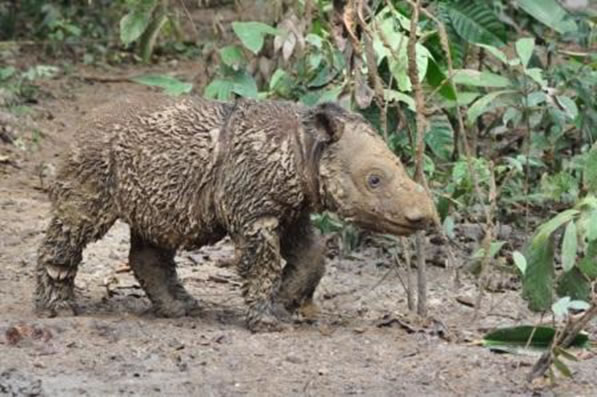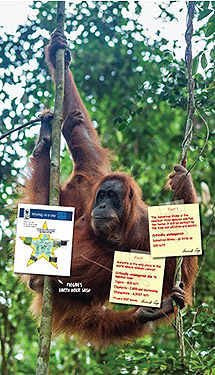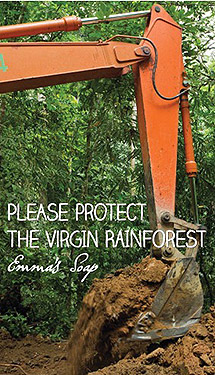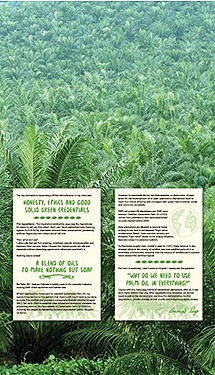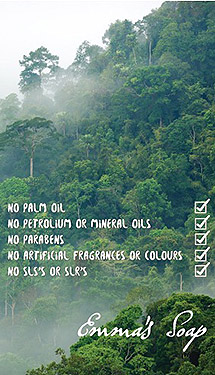The inspiration behind my soap was the ingredients. It’s easier to tell you first what I don’t use. Harsh petrochemicals, foaming agents (SLS’s & SLR’s), manmade chemical base preservatives (parabens), artificial fragrances and colours, are all left out.
Then what do I use? I select oils that are first pressing, unrefined, organic where possible and beeswax from my own hives. I choose the highest grade raw oils and materials without bleaching agents and refinement, that’s it nothing else is added! ‘A Blend of oils to make nothing but soap’.
Palm Oil is not on the list of Emma’ ingredients - Sodium Palmate is widely used in the cosmetic industry, causing both direct rainforest and habitat loss.
Sustainable Palm Oil - or is it?
Whilst I applaud the movement to establish sustainable Palm Oil, my research has led me to the opinion that there is still much work to be done to make this credible and provide a transparent Material Identity Scheme (MIC). Set up in 2004 to establish clear ethical and ecological standards for producing palm oil, the Roundtable on Sustainable Palm Oil (RSPO) currently the largest sustainability-focused organisation within the palm oil sector. However its standards do not ban deforestation or destruction of peat lands for the development of oil palm plantations. Plantations need to meet the criteria of being well-managed with good environmental, social and economic standards. RSPO set a date! All plantations pre-2005 were exempt.
Certified Sustainable Palm Oil (CSPO) comes from plantations that were established on land cleared before 2005!
New plantations are allowed to remove forest as long as the land is not deemed "high-value conservation forest." Each member country can interpret "high value" based on its unique situation, basically subject to personal opinion.
Furthermore, supply chain model is used for CSPO. ‘Mass Balance’ is also allowed which is the mixing of certified and non-certified palm oil in a controlled environment, ensuring that the volume of certified palm outputs never exceed the certified inputs!
For me it is contrived, I don’t want to nit-pick: I merely ask the question “Why do we need to use Palm Oil in everything?’ I agree with the many arguments of established plantations, after all, it can store more carbon than any other vegetable crop. However, we do not need to add to the demand and continue the deforestation, habitat degradation, climate change, animal cruelty and indigenous rights abuses?
The Problem
The Biggest Palm oil plantations are in Indonesia stretching across 6 million hectors (size of Belgium) with plans (as of 2015) to add a further 4 million hectares, the largest producer of palm oil yielding 33.5 million tonnes in 2014! With 96% being produced on Borneo and Sumatra
The entire production is derived from Indonesian rainforest, which ranked third in the world next to the Amazon and Congo basins.
The destruction of the rainforest involves removing the native forest, burning invaluable timber and the remaining forest undergrowth, damaging peatland, producing far more emissions than biofuels can remove. The fires alone emit immense quantities of smoke into the atmosphere which makes Indonesia the third highest greenhouse gas emitter in the world.
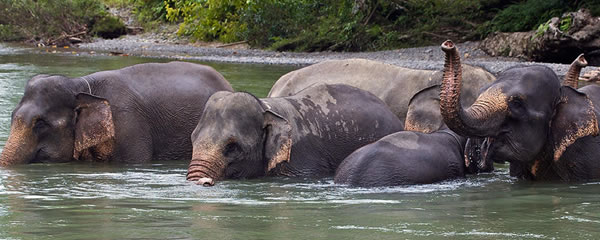
Such deforestation not only harms the environment but is a serious threat to already endangered species, human rights abuse too. Child labour also debit bondage where a person pledges labour or services as a security for repayment of debt or other obligation - debt slavery can be passed on from generation to generation.
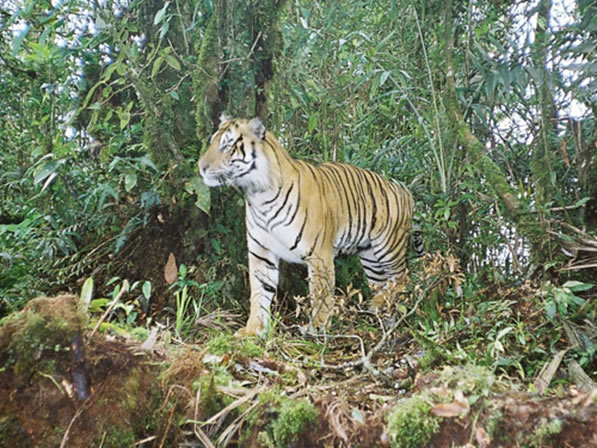
A conservation Emergency
The Indonesian island of Sumatra holds (what little is left) some of the riches and most diverse tropical rainforest home to 59 mammal species, 6 species of primates and 192 bird species. Sumatra is the only place in the world where tigers, rhinos, orangutans and elephants coexist.
Critically endangered in Sumatra due to habit loss, 2007 survey of numbers that remain in the wild:
The Sumatran Rhino, the smallest rhino species hairy with two horns, - as little as 100 left
The Sumatran Tigers, rare subspecies that only inhabits Sumatra - 400 left
Sumatran Elephant, smallest of the Asian elephants - 2,800 left (2016 as few as 1300)
Orangurtans - £7,300 (recently surveyed with barely 6300 left)
The numbers are decreasing with no prospect of recovery.
The power to prevent this conservation emergency is in you the consumer.
